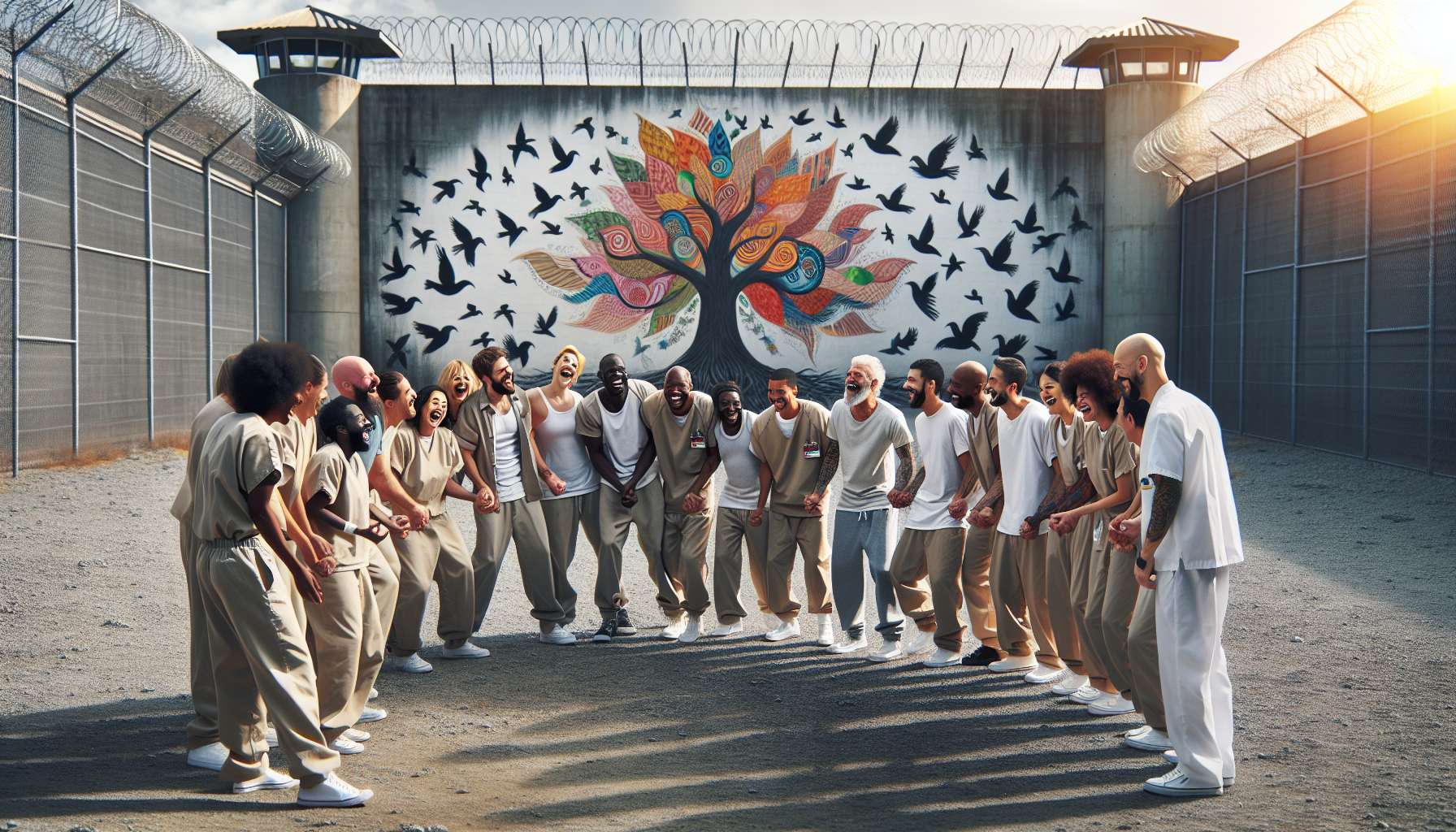5.8 – Laughter therapy in correctional and reintegration settings

Laughter therapy finds a particularly relevant application in prison and reintegration settings, where it provides numerous benefits for psychological well-being, emotion management, and the resocialization of incarcerated individuals. Faced with the challenges of imprisonment, such as isolation, violence, and loss of identity, laughter appears as a valuable tool to preserve one’s humanity, create connections, and envision a future.
From a psychological standpoint, regular laughter exercises can significantly reduce stress, anxiety, and depressive symptoms, which are often prominent amongst prisoners. By stimulating endorphin secretion, known as “happiness hormones”, laughter brings about a sense of relaxation and appeasement which helps better manage daily prison-related stress. It also enhances self-esteem, allowing for a return to a positive self-image despite stigmatization. Regular laughter workshops can thus contribute to preventing self-destructive or aggressive behavior and to reducing risky actions.
Inspiring example: At Strasbourg’s detention center, weekly laughter yoga workshops have been offered to volunteering detainees since 2017. Lead by a trained instructor, they provide laughter exercises, breathing patterns, and moments of conversation. Participants have testified an improvement in their morale, sleep, and their ability to put things into perspective. Some even continued practicing laughter upon their release, as a tool for resilience. An outstanding example of the transformative power of laughter in detention.
From a relational standpoint, shared laughter creates a different form of communication and connection within the prison setting. Surpassing the usual realities (detainee/guards, co-detainees…), it instills a climate of trust and conviviality conducive to tension easing. Group laughter workshops provide an opportunity for participants to discover each other differently, to cooperate and to experience a moment of lightness in a deprivation context. For individuals whose interactions are often filled with mistrust and power dynamics, laughter provides a lifesaving bonding and humanity space.
Remarkable anecdote: During a laughter workshop in a women’s prison, a usually very closed-off inmate burst into a powerful and contagious laughter during an exercise. Surprised herself by this liberating laughter, she confessed at the end: “I didn’t think I was capable of laughing like that anymore. It reminded me of the person I used to be and that I can still be despite the bars”. A beautiful testament of laughter’s power to reconnect with oneself and others while incarcerated.
But laughter is also a fantastic lever of accountability and a projection towards reintegration. By cultivating optimism, creativity, and self-confidence, it rallies the personal resources necessary to give meaning to one’s sentence and prepare for the release. Laughter workshops can be the starting point of a change dynamic, encouraging participants to commit to a training, therapy, or professional reintegration project. Some even become “laughter passers” to their fellow inmates, thereby initiating a virtuous circle of support and shared responsibility.
For correctional staff, often faced with a difficult and wearing job, laughter therapy is also a valuable stress management tool and a burnout prevention method. By integrating laughter relaxation and team-bonding spaces into their work environment, they can better regulate their emotions, strengthen their team solidarity, and maintain a professional posture suited to inmates. Pioneer establishments like the Oudenaarde prison in Belgium have trained “laughter coach” officers to lead let-go sessions amongst their colleagues.
Concretely, laughter therapy can take various forms in the prison environment:
– Weekly laughter workshops for detainees, lead by trained professionals and integrated into the establishment project
– Daily “laughter breaks” in the exercise yard or living units, initiated by detainees or referring guards
– Staff training for laughter exercise leading and positive communication with detainees
– Laughter integration in socio-cultural, sporting, or training activities offered in detention
– Comedy shows and events involving detainees, staff, and outside speakers to break down relationship barriers
Among the exercises particularly suited to the prison context, we can mention:
– Laughter breathing exercises standing or sitting, to relieve tension and recenter oneself
– Collective laughter circles, creating a joyful “here and now” connection
– Humorous role-play games to defuse tense relational situations
– Positive visualizations stimulating resources and projecting oneself towards the future
– Team laughter challenges reinforcing cooperation and shared responsibility
For it to be fully beneficial, it’s important for laughter therapy in prison to be integrated in a lasting and coordinated manner into the establishment project, in connection with the various services (Penitentiary Integration and Probation, healthcare units, training-work, etc.). It calls for a framework that is both secure and emancipating, carried by a management committed to a humanistic approach to detention. Laughter should not be instrumentalized but remain a tool to serve the well-being and reintegration of individuals, respecting their dignity.
Inspiring example: At Villepinte’s detention center, an innovative “Breathing Module” project was implemented for inmates nearing the end of their sentences. For three months, they participate in intensive workshops combining laughter yoga, nonviolent communication, meditation, and exit preparation. The goal is to provide them with keys to manage their stress, communicate better, and construct a life project for outside. The initial feedback indicates a decrease in tensions, remotivation, and better future projection for participants. An excellent example of the complementarity between laughter and other approaches in a reintegration journey.
In conclusion, by reintroducing lightness and humanity within walls, laughter therapy constitutes a tremendous tool for resilience and reintegration for inmates and their supervisors. A practice both deep and light, to crack open a glimmer of hope and life via shared laughter.
Key takeaways :
– Laughter therapy is especially pertinent in a prison setting, where it brings about many benefits for psychological well-being, emotion management, and the resocialization of inmates.
– From a psychological standpoint, laughter allows stress, anxiety, and depressive symptoms to be reduced, while enhancing self-esteem. It can contribute to preventing self-destructive or aggressive behavior.
– Relationally, laughter creates a different type of communication and bonding within the penitentiary setting, instilling a climate of trust and conviviality conducive to tension soothing.
– Laughter is a lever for accountability and a projection towards reintegration, cultivating the optimism, creativity, and self-confidence necessary to give meaning to one’s sentence and prepare for the release.
– For penitentiary staff, laughter therapy is a stress management and burnout prevention tool.
– Laughter therapy can take various forms in a prison setting: weekly workshops, daily breaks, staff training, integration into activities, comedy shows, and events.
– To be fully beneficial, laughter therapy should be integrated in a coordinated and lasting manner into the establishment project, providing a secure and emancipating framework serving the well-being and the reintegration of incarcerated individuals.
👉 To download docx (Editable) file click here : Click here
👉 To download PDF file click here : Click here
👉 To download MP3 file click here : Click here



















































































